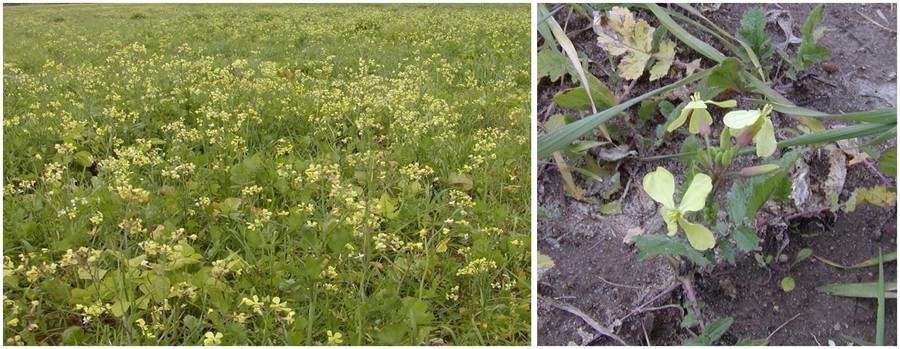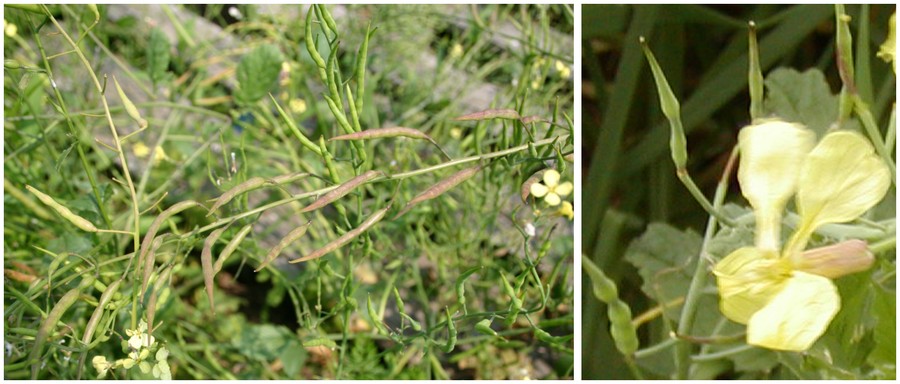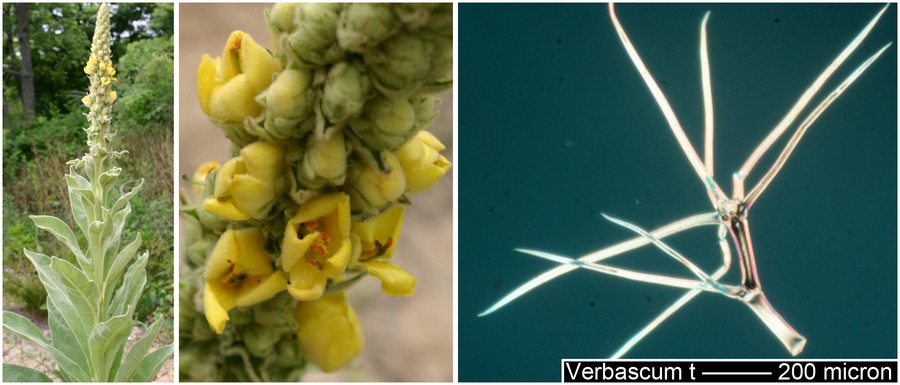Question 7
Is it a remarkably adaptable plant?
![]()
Weeds can change form to suit the environment and to adjust to a variety of soil conditions. I compare weeds to a thug on the run from the law, who shaves or grows his mustache, dyes his hair, dresses as a woman, moves to the cold wilderness of Alaska, or subsists on eating garbage or foraging for bugs and bark. Renegade, unwelcome weeds can become smaller or taller, develop more male or female gender cells, as needed, grow faster, change shape, blend in with the crowd, flourish in the shade or the sun, tolerate drought or flood, and consume mere scraps in infertile soil in order to survive.
• While the presence of Red sorrel, Rumex acetosella, (Q#5) theoretically indicates an acidic soil, Red sorrel will also thrive in balanced soil.
• Dandelions, Taraxacum officinale, (Q#1) will grow in the dry, root-covered, compacted shade of a Norwegian maple or in the full sun of a well-maintained lawn or garden bed, and adapt to become long and spindly or short and compact to suit the site.
• In the lawn, Heal-all, Prunella vulgaris, (Q#1) and several of its Mint family cousins will form smaller shorter foliage under barrage by a mower, continue to extend more adventitious roots, mature more seeds to compensate for the attack, and spread to flower beds.
The plasticity that helps these plants outlast difficult situations warns of their potential for weediness.
Among Roses, the two most accepting and tolerant types are the Rugosas, spp., which can become almost weedy, and the Multiflora, spp., an invasive weed of the wild woods (Q#2). By contrast, the other more cultivated and refined Roses like the hybrid teas, ‘Royal highness, spp.’, ‘Prima ballerina, spp.’ or ‘Princesse de Monaco, spp.’, require sun, sufficient moisture and nutrition to bloom gracefully and fragrantly. These well-bred hybrid teas don’t proliferate, unless carefully cultivated. They don’t adapt to shade, too much heat or cold, too many midges or cane borers, diseases like black spot or mildew, low fertility, imbalanced pH, too much or too little water, or compacted soil. They behave like the Princess in the fairy tale who could tell that the mattress had a pea under it and couldn’t sleep until it was removed. Weeds don’t behave at all like that Princess, since very little upsets them.
Weeds mimic other plants. This protects them from eradication by the unsure weeder, a Darwinian survival of the fittest effect. An escaped convict would not wear his prison uniform any longer than necessary to evade capture—he would steal an outfit from a clothesline or otherwise find a disguise to help him mingle with the crowd. Weeds appear to almost size up the optimal location, leaf shape, height, plant shape and availability of pollinators or wind where other plants similar to that weed grow. As they blend in, the weeds move in and take over and avoid early attack. Or perhaps it happens randomly over time, and the weeds that succeed are the weeds that have strategies most closely allied to those of the competitors they outrival.
As writer Michael Pollan points out, we have no words to describe plant consciousness or intentionality. We can more easily interpret the world through our own human analogies. When the science fiction character “the Terminator”, in the movie by that name, landed in the present from the future, nakedly obvious, his first action was to mug a biker, steal his duds and his wheels and then take off, looking like any other biker-dude. The Terminator was a robot covered with human flesh and he had extra senses—displayed as a computer screen on film—that helped him measure up the perfect target by height, weight, body type and to factor in the availability of a set of wheels plus keys to start up the engine. I compare the ability of weeds to size up the situation and then adapt quickly to that similar ability in the Terminator. And like him, when temporarily defeated they “will be back”.
Once weeds adapt to where they land, they spread widely, and generate abundant offspring, either as they creep along on roots or as they reproduce a multitude of seeds or other generative parts. Just how they hide in plain sight varies from weed to weed. Many weeds do look like their cultivated cousins, like those wild and weedy Grasses hidden in lawns, or Brambles amidst the Roses. Sturdy peasant stock of weed ancestors contributed some hardy genes to their hybrid cousins. Other weeds have qualities that benefit from the same micro-climate as non-family look-alikes. While flexibility, abundance and vigor get top marks in a plant that you want, those same things make a plant that you don’t want, weedy.
Immense genetic plasticity that extends into gender bending in certain weeds
Spotted knapweed, Centaurea maculosa, described in lurid detail in Q#2 used its quick change artistry to out-rival natives and overrun western pastureland. Genetic plasticity and rapid population growth enables several weeds like Common groundsel, Senecio vulgaris, and Perennial sowthistle, Sonchus arvensis, (both in Q#2) to acclimatize to survive herbicides faster than scientists can say “new formula”.
Wild radish, Raphanus raphanistrum blooms and sets seed recurrently from early summer through fall. Genes vary extensively even within each plant, so even from flower to flower on the same plant it provides an in-house all-you-can-use buffet of genes! Buds, flowers, and seedpods can form at the same time, and easily adjust their genetic makeup, using one gene from Group A and 2 from Group B, or other combos, to enhance survival. Then this “gene” -eration regroups with even more potent traits over its next cycle, during its long season of regular re-blooming. It cross-breeds with the cultivated Radish and other wild and well-bred Brassica family plants to change and even corrupt crop features. It mutates quickly enough to overcome attacks from herbicides.
Wild radish takes this even further. Each hermaphroditic flower of Wild radish contains both male and female reproductive parts. Flowers will change gender to optimize chances of survival. If hungry insects attack it, genes prompt its flowers to grow earlier and produce male pollen instead of seeds. The out-going order of pollen then fertilizes nearby uneaten plants, especially those which still have the energy to nurture seeds to full maturity. This adds to the exponential genetic spread. When flowers reflex backward, they display their stamens and pistils more prominently. As it exposes its parts, it facilitates pollen flight and insect access for cross-pollination. What an obliging procreator!
Each Wild radish plant can produce about160 seeds in seedcases that burst open and spread. Each properly fertilized seed can create a new plant, another 160 possible plants. Each of these 160 plants produces 160 seeds and so on. Seed supply swells exponentially as more plants breed and as wind and pollinators keep its pollen aloft to fertilize other plants. This may result in a previously cultivated bed that becomes a sea of herbicide-resistant, yellow blooms that crowd out any potential crop.
Seeds that ripen at the same time as the crops planted in the same conditions also help Wild radish to intermingle seamlessly. It has adapted genetically to grow at the optimum time with the maximum disguise among similar looking crop seeds and crops.
If a farmer spreads seeds they may have collected or purchased that contain a few renegade Wild radish seeds, they will also assist the weeds. Seeds will germinate anytime they land on broken, open soil or anytime they receive moisture from spring to fall—a long season. The seeds of weeds and cultivars don’t know what the farmer has in mind. Both emerge when conditions warrant germination. But the weeds tend to be more competitive or better armed than the fussier chosen crops.

Left: Wild radish overwhelms a previously cultivated field Right: Flowers reflex backward
Once pollinated, flowers become seedpods that squeeze in, like a cinched waist, between the enclosed lumpy seeds. (Smoother, unfertile pods lack the cinched waists that form along the bead shaped seeds within fertilized pods.) Fertilized seedpods divide crosswise across their “waist” when ripe, then drop off. Protected seedpods that resemble little tootsie rolls get spread by animals, wind, soil movement, vehicles, water, even sea water, but most significantly by people—as a contaminant in harvested grain and hay.

Left: Seedpods divide crosswise when ripe, then drop off Right: Fertile seedpods form lumps around seeds
Like Wild radish, Common mullein, Verbascum thapsus, once established, grows short generations of seeds repeatedly and rapidly. It changes gender to optimize its chances for survival. These “gene”-rations develop new traits to adjust to even difficult new locales and to resist herbicides. As one of the tallest herbaceous plants in barren areas, and as one of longest bloomers, Common mullein attracts optimal numbers of pollinators. This too speeds up its genetic shifts.
The gender-morphing flowers of Common mullein change from early-maturing female to later-maturing male parts, so it often cross-fertilizes, but can self-fertilize as well. Its 200-300 flowers on 10” flower spikes bloom 2-5 at a time from the bottom of the spike up to its top, for a day a piece from June - September over an extended, staggered bloom cycle. Each fertilized flower creates a 2-sectioned, oval, hard, woolly seed-capsule that splits into 2 “valves”, or sections, which release up to 800 seeds. Each plant can generate 180,000 to 240,000 seeds which remain viable for over 100 years—even as long as 700 years! Seeds fall close to plants and despite a lack of special dispersal mechanisms, seeds are tiny enough to ride unnoticed on shoes, paws, or tires to other locales.
A French expression “to plant mulleins” means “to work for nothing” and reflects both its ability to grow where it chooses, and not where it gets planted; and to produce flowers where little else receives sustenance. And it’s not just its ability to seed that helps it to succeed easily.
Common mullein’s top growth is covered by deceptively soft-looking hairs that actually grow spiky and branched. These hairs provide its pollinators—hover flies and bees—a good grip so they can land and help it reproduce. Hairs adapt to grow denser to protect it from moisture loss from drought, wind, and frost; hairs irritate mucous membranes and the skin of the sensitive, so they deter grazers, birds (except Goldfinches and chickens), and human consumption; hairs also provide a barrier against herbicides; and hairs hold water drops. Under the microscope the fierceness of its sharp, crossed and branched hairs becomes visible. What an impressive, but subtle, barrier!

Left: Common mullein’s height Center: Sequential bloom of flowers Right: Common mullein hair photo*
*Circular Polarized Light Illumination by Microlab NW http://www.microlabnw.com
Contrary to its deceptive soft look to the naked eye, its spiky branched hairs make skin pink with mild dermatitis. “Quaker” ladies, forbidden the use of “rouge”, rubbed it on their cheeks to encourage a fetching blush which gave it a common name of “Quaker rouge.” In the wild, those who have tried to use it as toilet paper have quaked and blushed in other areas and recommend avoiding it for such a use.